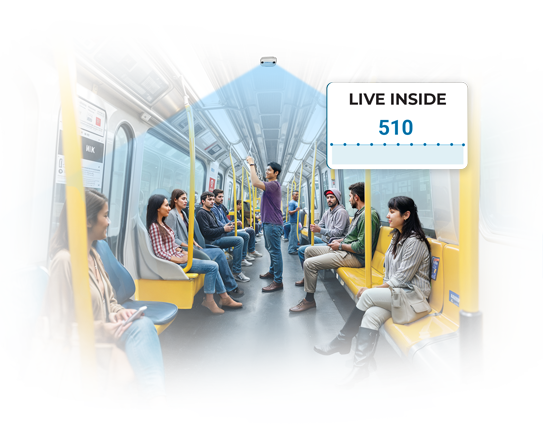In a busy train station, every second counts. Crowds build quickly during rush hour, boarding times shrink when delays hit, and even small inefficiencies can ripple through an entire transport network.
For transport operators, the challenge isn’t just moving people - it’s managing flows in real time to keep operations safe, smooth, and efficient. That’s where people counting technology becomes more than a measurement tool. It’s a decision-making engine.
Managing Peak Passenger Flow
Rush hours, holiday travel, event days - transport hubs face predictable spikes in traffic, but the scale can still surprise. With accurate people counting, operators can see exactly when and where passenger numbers rise, allowing them to:
-
Open additional gates or ticket counters
-
Redirect flows to underused entrances
-
Communicate expected wait times or alternative routes
This proactive approach prevents dangerous crowding, shortens queues, and keeps services running to schedule.
Improving Safety Through Live Occupancy Data
Safety regulations often require strict limits on the number of people in specific zones, from platforms to waiting areas. By monitoring occupancy in real time, transport managers can spot and address bottlenecks before they become safety hazards.
During emergencies, live data helps guide evacuation strategies - ensuring passengers are moved through the safest, least crowded routes.
Optimizing Staff Deployment
A transport hub’s staffing needs aren’t static. Passenger assistance, cleaning teams, and security patrols should be concentrated where they’re needed most.
People counting data allows managers to redeploy staff in real time - for example, assigning more personnel to assist with boarding when a train arrives late or increasing cleaning efforts in areas seeing high footfall after a weather event.
Enhancing the Passenger Experience
Travellers value predictability. With live occupancy data, operators can integrate information into passenger-facing apps and displays, showing less crowded platforms, faster security lines, or quieter seating areas.
This empowers passengers to make their own choices, improving satisfaction while naturally spreading demand across available spaces.
Planning for the Future
Beyond daily operations, people counting builds a valuable historical dataset. This helps planners forecast demand, justify infrastructure investments, and design new layouts that handle passenger volumes more effectively.
By combining occupancy trends with ticketing and timetable data, transport authorities can make the case for everything from schedule adjustments to platform expansions.
One Platform, Many Integrations
For transport hubs with complex operations, data silos are a major challenge. Vemco Group’s platform unifies people counting with existing systems - from ticketing and security to building management and passenger information displays - so operators see the full picture in one place.
Whether it’s a regional train station or an international airport, this integration makes scaling smarter, faster, and more consistent- with local support wherever you operate.
When you can measure movement, you can manage it.
For transport hubs, people counting isn’t just about numbers - it’s about keeping cities moving, safely and efficiently.
See how Denmark's busiest transportation hub, DSB, is optimizing operations.
Frequently Asked Questions
How does people counting help manage crowds in transport hubs?
People counting systems provide real-time data on passenger flow, enabling transport authorities to manage congestion, optimize train and bus schedules, and maintain safety during peak hours.
How can Vemco’s occupancy management system improve safety and compliance?
By monitoring real-time occupancy levels, Vemco’s system helps ensure compliance with safety regulations, avoid overcrowding, and manage queues efficiently in high-traffic spaces.
Is Vemco suitable for public transport hubs and airports?
Yes. Vemco’s solutions provide real-time passenger flow monitoring, predictive analytics, and occupancy alerts, helping transport authorities manage crowds and improve commuter experience.





